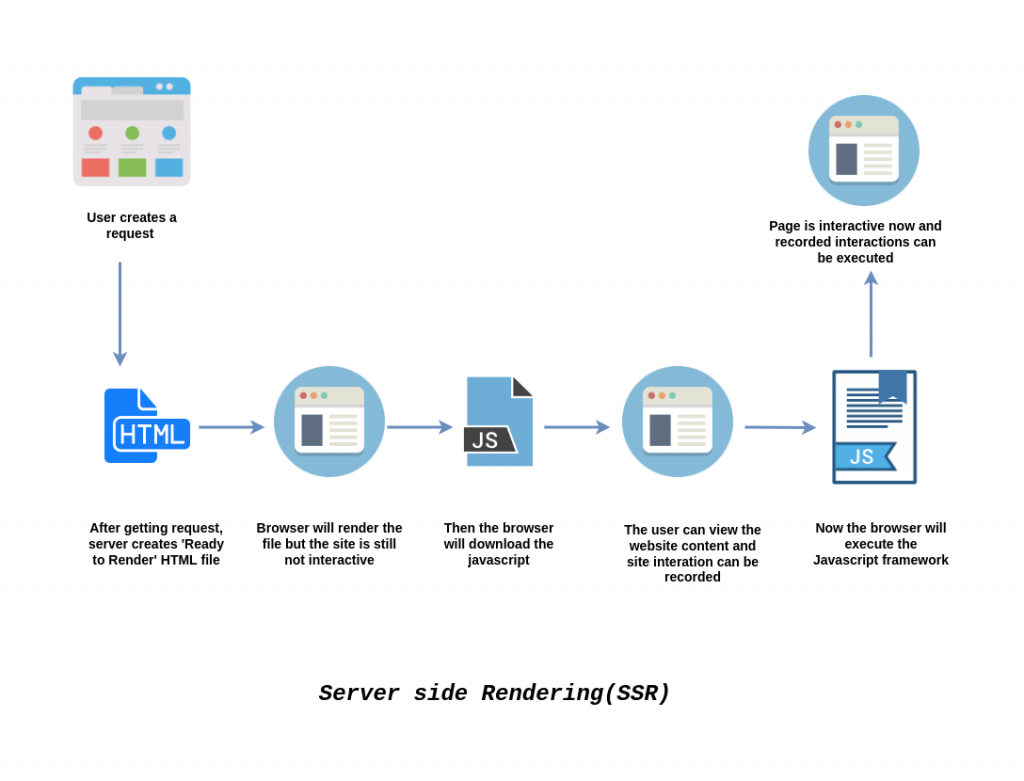
Magento 2 speed optimizations are everyone’s need that is why we keep updating you on the latest features how we can speed up our Magento stores.
In our previous blog, we discussed how we can Speed up Magento 2 using Preload, Prefetch, and Preconnect.
Now, we will discuss Server-side rendering and how it will help Magento 2 store.
Server-side Rendering(SSR)
There are 2 ways for rendering a web page –
- Client-side rendering is one method, in which the rendering is completed by the user’s browser.
- The other is server-side rendering, which completes the process on the server.
The most popular technique of showing content is through SSR. It works by translating HTML files on the server into information that can be used by the browser.
Your browser sends a request to the server when you visit a website. Your browser interprets the content and shows the page after this request has been processed.
In just a few milliseconds, data from the database is retrieved, an HTML page is created, and the page is sent back to the browser.
The page, layout, CSS, JavaScript, and HTML content are loaded in the first request with SSR. The server will deliver HTML responses that are ‘Ready to be rendered’.
The user’s browser renders the page and downloads the JavaScript right away so that it can be viewed. Then, for interactivity, it uses React.
In client-side Rendering, the server responds to the client’s browser. After that, the browser downloads JavaScript and runs React. The page will become viewable and interactive after some time.
Because your server has already converted the HTML for rendering, SSR is faster, whereas CSR requires more JS to be downloaded, which means more JS to parse.
The content, on the other hand, necessitates a second HTTP request to load. Finally, more JS is used to create the template. The second request will only be made once the document has been loaded.

Pros of SSR
- The first time you visit the page, it loads faster.
- Excellent for static websites.
- Because of its speed, server-side rendering is a suitable alternative for rendering JavaScript for internet marketing.
- There will be no loading time delay for the end-user. Client-side rendering causes loading page flickers, although SSR does not.
- The faster Google and other search engines can crawl your pages, the better for your crawl budget. This ultimately improves the user experience on your website.
Cons of SSR
- Because you’re using your own company’s server, it’s more expensive.
- Interactions between non-rich sites.
- With highly engaging pages, frequent server queries might cause bottlenecks.
- Higher latency, which makes it more vulnerable.
SSR in Headless Development
Headless development means decoupling backend with frontend. That means the backend is used for API purposes and front development and site rendering run on modern frameworks like Reactjs.
SSR is a vital part of headless development because, in order to fetch the content generated by the API, SSR uses a Node.js front-end server. Following that, it generates HTML and transmits it to the browser.
This indicates that the HTML sent to the client already contains dynamic content, which eliminates the indexing issue. We can create SEO-friendly websites utilizing this strategy.
Webkul offers headless commerce services built on React, Vue, and their frameworks like Gatsby.js, Next.js, Vue Storefront, Shopify Hydrogen, and Adobe Commerce PWA Studio.
How SSR helps Magento 2 store
Initial Load Time
The average time it takes a user to load your site for the first time is referred to as the initial load time.
Before converting HTML to useable content on the browser, CSR loads base HTML, CSS, and all essential scripts. As a result, SSR’s initial page may load much faster.
Caching
Caching is a method of storing copies of files in a cache (or a temporary storage site) so that they can be retrieved faster.
For reusable scripts on a user’s workstation, browsers and web servers use caching methods. SSR will always send requests to the server, resulting in a longer load time.
However, because the scripts are fetched by the browser from the cache, caching measures can aid improve rendering speeds.
Impact on SEO
It’s critical to optimize your website for search engines. However, in order for this to work, your web page must have the appropriate information for search engines.
After all, search engines like Google crawl your site’s metadata with automated bots.
SSR compiles entire pages with the appropriate metadata. They’re transmitted to the front-end after getting the final HTML content.
Whether or not search engine crawlers allow the usage of JS, this solution assures that the page metadata remains accurate.
SSR sites, on the other hand, are more SEO-friendly than CSR sites.
Dynamic Content Loading
Servers are frequently hosted on computers with a lot of processing power and fast networking speeds.
That’s why you can rely on servers to provide the extra horsepower required to handle massive requests.
Client machines, on the other hand, have limited computational capability. This means that the time it takes to render content will be longer.
As a result, if your site requires dynamic content rendering on a regular basis, SSR is the superior option.
Conclusion
When it comes to delivering business results, a lot is relying on web design and development.
As a result, it’s important for marketers to understand how each step of the process works and what tools or platforms might help improve online performance.
You can work effectively with developers and make decisions that will benefit your SEO efforts if you understand how server-side rendering affects your site.
Need Support?
Thank You for reading this Blog!
For further more interesting blogs, keep in touch with us. If you need any kind of support, simply raise a ticket at https://webkul.uvdesk.com/en/.
For Magento 2 Elastic search, please follow –
Our Cloudkul Blogs
Elasticsearch, Fluentd, and Kibana (EFK)
Setting up Elasticsearch, Logstash, and Kibana for centralized logging
Managing and Monitoring Magento 2 logs with Kibana
Our store modules –
You may also visit our Magento development services and quality Magento 2 Extensions.
For further help or query, please contact us or raise a ticket.